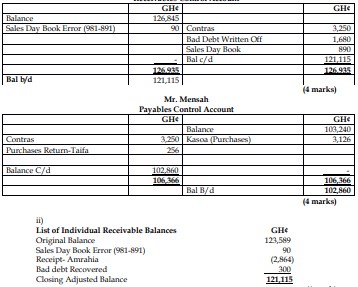- 5 Marks
Question
Financial reporting is not an end in itself but a means to an end. The end game of financial reporting is to provide value to the user of the information. In the local government, financial reporting must deliver the expected value to the users.
i) Explain the objective of financial reporting in the public sector.
ii) Explain the usefulness of financial statements of a Metropolitan Assembly to three of its primary users of the information.
Answer
i) The objective of financial reporting in the public sector is to provide useful information for accountability and decision-making purposes. Thus, financial reporting is concerned with the provision of financial information that supports the accountability and decision-making needs of the users. In terms of accountability, financial statements serve as a source of information to the users to assess how well the reporting entity applied the resources entrusted to it in the delivery of public value. It enables the users to question the public managers on the use of public resources. Thus, financial statements serve as a tool for demonstrating and assessing accountability of public institutions and their managers. Financial statements also provide information that supports decision-making in the public sector by both the public managers and the users. For example, the decision relating to the allocation of resources is supported by the accounting data. Similarly, the information on the financial performance and propriety of an entity may influence the decision to re-elect the managers of the entities in a democratic context.
(2 marks)
ii) Primary users of financial information of an Assembly include:
- Local citizens
- Assembly members (representatives)
- Central government
- Rate payers
- Lenders
- Donors
Local citizens are service recipients of the local government and therefore may need the financial information to assess:
- The cost of services provided by the Assembly and the sustainability of the service provided.
- The accountability of the local managers in terms of how well the resources are used.
Assembly members are representatives of the local citizens in the governance of the Assembly and therefore they need the information to assess:
- Whether there is compliance with the legally adopted budget of the Assembly.
- The performance of the programs and projects of the Assembly.
- Accountability of the local managers.
Central government transfers resources to the Assembly and also grants it the enabling law to operate. Thus, the government needs the financial information to exert accountability in the Assembly and also to make decisions relating to resource allocation.
Rate payers are providers of financial resources to the Assembly and may desire to know how well their rates have been used to provide local services.
Lenders like banks use the financial statements in determining the financial condition of the Assembly to decide whether to lend or not.
Donors support the Assembly with financial and non-financial resources and therefore need the financial statements to assess accountability for the donor and compliance with donor agreements.
(Any 3 points @ 1 mark each = 3 marks)
- Topic: Financial Statements Discussion and Analysis
- Series: NOV 2023
- Uploader: Sarah


